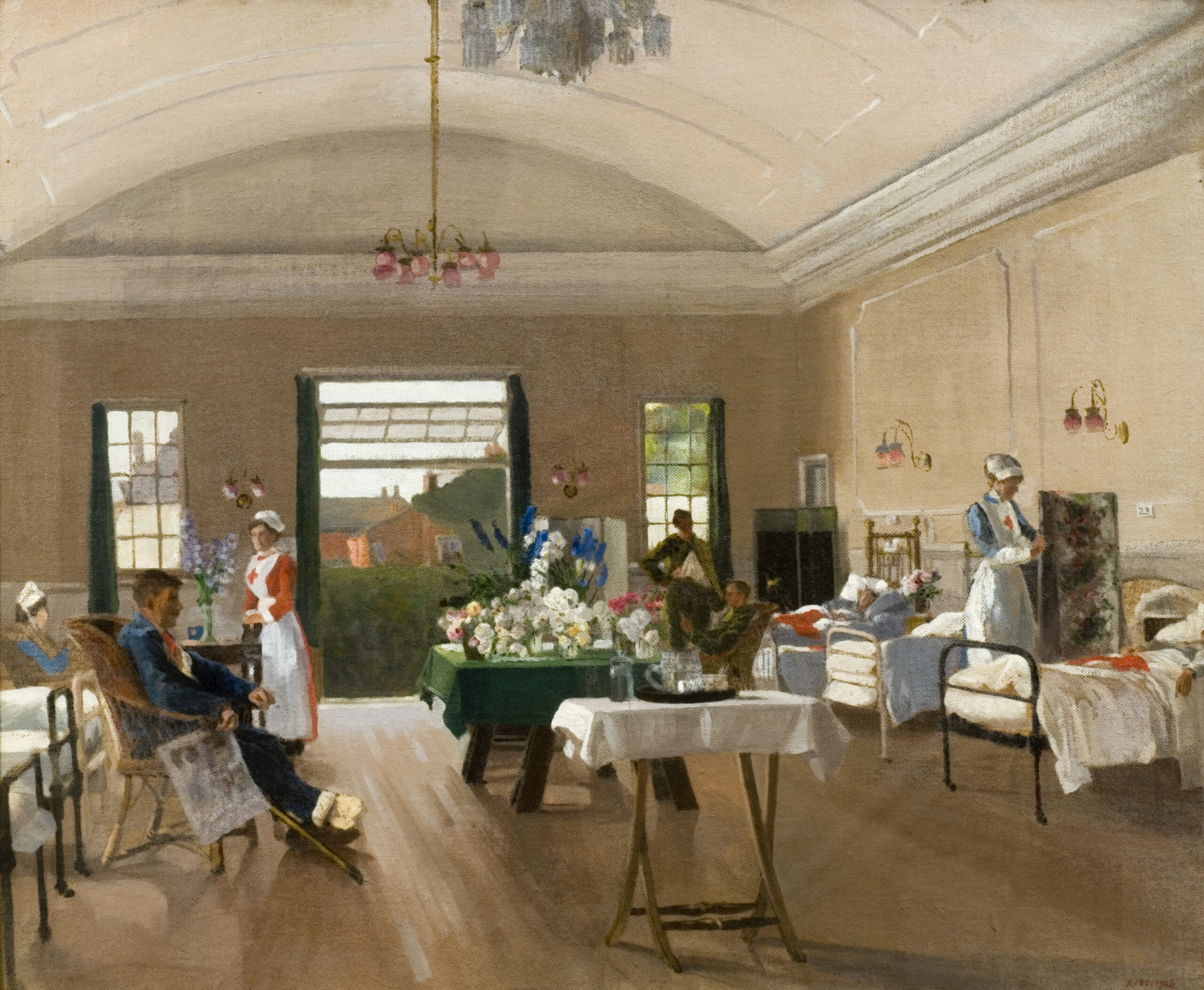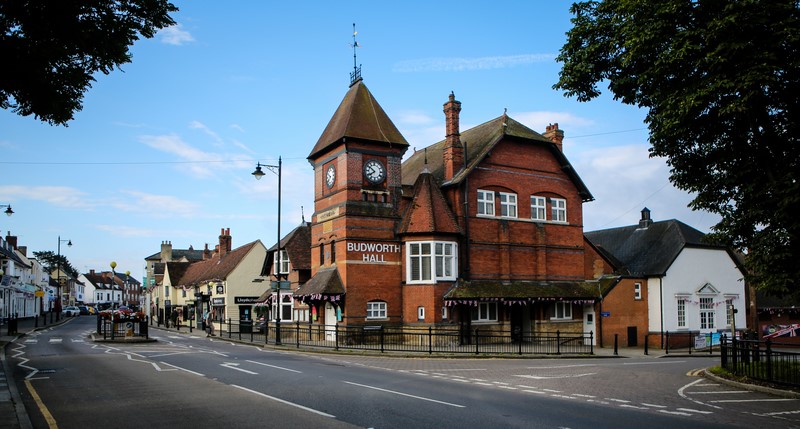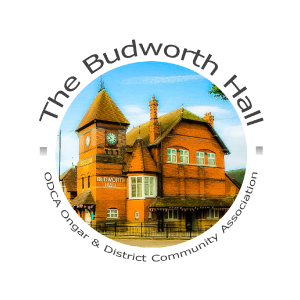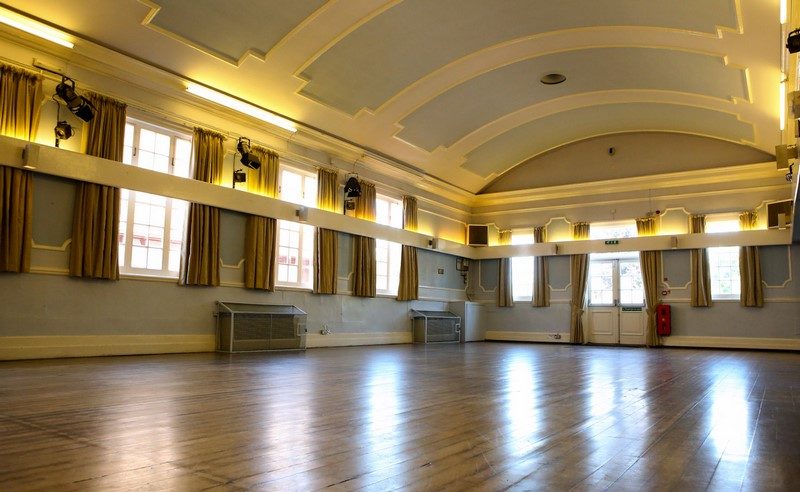PAST HISTORY

The above picture shows part of the Ballroom in use as a Hospital in during the First World War.
Budworth Hall, a landmark Grade 2 Listed Victorian Building, in Chipping Ongar High Street, was erected in 1886. It houses a Ballroom with adjacent Kitchen and Licenced Bar, a Concert Hall, Meeting Room and a Coffee Bar and Restaurant.
The information in this Section was mainly extracted from the actual Conveyance, Sale and other original documents plus newspaper reports held by Ongar and District Community Association.
Captain Philip John Budworth died on the 9 January 1885. He lived at nearby Greensted Hall. The Trustees of his Will, by a Conveyance dated the 24 June 1886, sold part of a field known as Great Bansons to a Reverend F.A Fane and others. The Land Tax Certificate dated 28 April 1887 describes the land sold by the Trustees as follows “all that piece of land of a field or meadow ground called Bansons Great Orchard or Great Bansons……………. containing a frontage to the high road or street hereinafter mentioned of fifty feet more or less and a depth of one hundred feet more or less.” This is the land on which the Budworth Hall stands.
At a public meeting held in Chipping Ongar on 3 June 1885 two Resolutions were passed:
“1st – That it is desirable that a substantial Memorial to the memory of the late Captain BUDWORTH be provided
2nd – That such Memorial take the form of a Building, to contain a large Room for Public Meeting, Reading and Recreation Rooms for the young men of the Town, and such other rooms as may be necessary, and that the Building so erected be called “The Budworth Hall”.
The minutes of the meeting also record that:
“The Rev’d F.A.S FANE who has had placed at his disposal a sum of money to be applied as he thinks fit, generously offers a very eligible site which he has purchased, for the purpose of erecting Coffee Rooms, and about £400, on condition that suitable rooms in the proposed Hall be set apart for carrying out the object he has in view. This offer was gratefully accepted”.
It was agreed to solicit subscriptions for a further £1,000 in addition to the £400 already mentioned.
A Committee of 15 persons were appointed. Subscriptions to be paid to the account of THE BUDWORTH MEMORIAL FUND, at Messrs SPARROW & Co’s BANK, Chelmsford.
In a letter dated 8 December 1885 Henry Gibson, a member of the Committee, wrote to the Committee referring to a meeting held on the previous Monday which he had attended, as follows:
“I am afraid the Budworth Hall Committee will have a difficulty in raising the remainder of the funds and yet it is very desirable that there should not be any debt existing when the opening of the Budworth Hall takes place…………. I have been an inhabitant of Ongar for a great many years and it occurs to me that this is a very favourable opportunity for carrying out my desire to do something for benefit of the town and coming forward at the present time I shall have the added pleasure of lightening the burden of the Committee which otherwise would I think have a heavy one……….Towards this deficiency I shall be happy to give £200 or so much of it as may be required and in this way we shall I hope start clear of debt”.
Henry Gibson lived at the White House in Ongar and was Clerk of the Peace for Essex. His son Herbert was also involved in the project.
The Architect was Fothergill Watson from Nottingham, who designed many buildings in the Nottingham area. The Budworth Hall is the only building in the South of England designed by him.
The estimated building cost, including furniture and fittings was £1,400. The final cost was about £1,600 for the building alone. The soliciting of subscription for the project had hoped to bring in £1,000, in the event only £846.0s.3d was raised. Henry Gibson paid the shortfall of the building costs. He also paid for the furniture and fittings. It is not known how much this cost him. The “List of Subscribers” shows that there were 146 Subscribers, most of whom donated in guinea’s (£1.05p). The Epping Division of the County Constabulary and other members of the Force donated£4.7s 6d. (see “List of Subscribers” attached)
The first brick was laid in 1886 and the Budworth Hall was formally opened on 9 February 1887. An extract from the local paper of the time reports “The building is designed in a style suited to our old English towns, of quiet gothic character, it is of red brick with moulded brick strings and red tiled roof, the plinth being in blue hard burnt bricks and grey coloured brickwork below”.
A public meeting was held on Tuesday 22 March, 1887 to consider what should be done to celebrate Her Majesty Queen Victoria’s Golden Jubilee. The meeting agreed that a clock should be placed on the Budworth Hall as a local memorial, the cost to be met by public subscription. A Jubilee Committee was elected. Money was raised mainly by means of Subscription Lists. Every householder was approached. Other sources of income were £10 from a Concert, £7 from a Chrysanthemum Show and five shillings from the sale of the photographs. In October an order was placed with Gillett of Croydon (now known as Gillett and Johnson) for a three dial clock with a 1.5cwt bell with illuminating apparatus, dials to be 4 feet in diameter, at a cost of £85. Mr Frederick Noble, the local builder, charged £23.38 to fix the clock in the tower. Gillet and Johnson still look after the clock.
In 1910 the Ballroom, said to have cost around £700 and known initially as the Essex Hunt Ballroom, was erected on the lawn at the rear of the Budworth Hall as an Annexe to the existing building. A report in the Chelmsford Chronicle dated 10 February 1911 on the Essex Hunt Ball of that year says that it was the first dance in the new Ballroom, with over 200 people attending. The report states that the new Ballroom had been specially built by a syndicate, with Mr H.E. Jones J.P. as the leading spirit. Details about the new building and a long list of those attending the Ball are also set out in the report. The Ballroom has a sprung dance floor.
From 1914-1919 during the First World War the Budworth Hall became a Convalescent Hospital for sick and wounded servicemen; officers were accommodated at nearby Blake Hall. Known as Budworth Hall Auxiliary Hospital, it was staffed by Essex/32 Voluntary Aid Detachment. A photograph taken in 1914 shows Nurses and Soldiers outside the Budworth Hall. Another photograph shows the Commandant (Matron), Miss Jones, with 29 nurses. Many were local women. At first patients were mainly Belgian Soldiers brought to England to convalesce. Initially the Hospital had 35 beds in two large wards, 22 in the Ballroom and the rest in the upstairs Concert Hall. In 1917, when the hospital had 51 beds, a temporary extension was built and the number of beds increased to 60. The Hospital, affiliated to the Colchester Military Hospital, closed on 22 January 1919. Some 1,333 soldiers received treatment during the Hospital’s occupation of the Budworth Hall.
On a wall of the Bar there is an oil painting showing the Ballroom in use as a Military Hospital. Painted by George Rose, a local Artist, the painting was exhibited at the Royal Academy in 1916. The picture was presented to Ongar and District Community Association by NHS West Essex when the Ongar and District War Memorial Hospital closed in 2008.
In 1925 renovation work was required to the building. A Garden Fete was held which raised sufficient money to paint the Ballroom and carry out several repairs.
Again, during the Second World War Budworth Hall was utilised for the War effort. In May 1940 troops were billeted in the Ballroom, Concert Hall and Committee Room. In February 1941 the upstairs Concert Hall and Committee Room were requisitioned for use as a rest centre for evacuees. In 1942 the building was used to house a British Restaurant. The Budworth Hall re-opened for public use on the 1 April 1946.
The inaugural meeting of the Ongar & District Community Association, who still run the Budworth Hall, was held on 28 June 1968. The Association is a Registered Charity. The Association celebrates it’s Golden Jubilee this year in June.
In 1986 the Budworth Hall celebrated 100 years of existence. A Victorian Town Day was held on the 5 July to celebrate the anniversary. Celebrations were held in the Town with shopkeepers dressing their windows in Victorian Style and a colourful parade was held through the High Street with the local people dressed appropriately. A celebration lunch was held in The Budworth Hall.
In February 1990 gales temporarily closed the building due to the state of one of the main chimneys. It was reported to be “wobbling in the wind”. All four chimney stacks were rebuilt to comply with the buildings Grade 2 Listed status, they were no longer needed as chimneys. Repairs cost in the region of £20,000.
To celebrate Her Majesty Queen Elizabeth II Golden Jubilee in 2002 the clock mechanism was electrified. The original mechanism is still in situ. At the same time major repairs were carried out to the clock dials, clock tower and the weather vane. The total cost was £16,300. Ongar Millennium History Society the Community Association and others raised the funds to pay for this work.
The many documents, including press reports, which the Association hold’s, show that during the Twentieth Century whilst there were good periods, in the main there were constant struggles with financial and other problems. This included an attempt to take over the building by a religious organisation. On a number of occasions the Budworth Hall came close to closure. I am pleased to say that currently our finances are in a sound state.
Without the help of the many dedicated volunteers who have helped run the building. The Budworth Hall may not have survived. Running, maintaining and improving a Grade 2 listed Victorian building is both challenging and costly.
In his book “Aspects of Ongar”, Michael Leach at Chapter 24 (pages 261-269) details the life of Captain Budworth and the birth of Budworth Hall in 1886 and how it evolved over the years.
Thank you to Michael Leach for looking at this section.
The Association would like to find a photograph of the Budworth Hall before the Clocks were installed in October 1887. Can you help?
Ongar & District Community Association.
March 2018
PRESENT AND FUTURE

We have exciting plans in hand to make the building more user friendly for people with mobility issues. Jackie Pepper, one of our volunteers and an architect, is completing plans which include new wheel chair access entrance doors with improved security, installing a disabled access toilet, improving access around the building and renovations to the ballroom. These will be extremely costly. To ensure we can move forward with these projects, we are hoping to obtain grants, donations and fund raise.
We urgently need to find volunteers who have the knowledge and ability to make applications for grants, organise fund raising activities and to seek donations. Please contact us if you or someone you know, has these skills and can help us.
The cost of maintaining, operating, and improving Budworth Hall is mainly funded by:
· Hiring out our great facilities
· Donations from the Budworth Trading Company who operate the Bar
· Fund raising events
· Coffee Bar and Restaurant
It is a constant challenge to make sure that our finances remain in a sound state. Currently, we are managing to do so.
Budworth Hall is in regular use by the residents of Ongar and the surrounding villages. Take a look at the Clubs and Events page to see the wide variety of local clubs and organisations which use our facilities.
All our spaces are attractive in character and available to hire for your own events.
If you are considering starting up or expanding a project or activity on a regular basis, we will do our best to meet your requirements. We will be delighted to help and encourage you.
To hire our facilities or obtain further information please get in touch with us.
Our contact details are as follows:
Address – Ongar and District Community Association
Budworth Hall
High Street
Ongar, CM5 9JG
Telephone – 07918 462 959
Email – budworthhall-ongar@outlook.com

